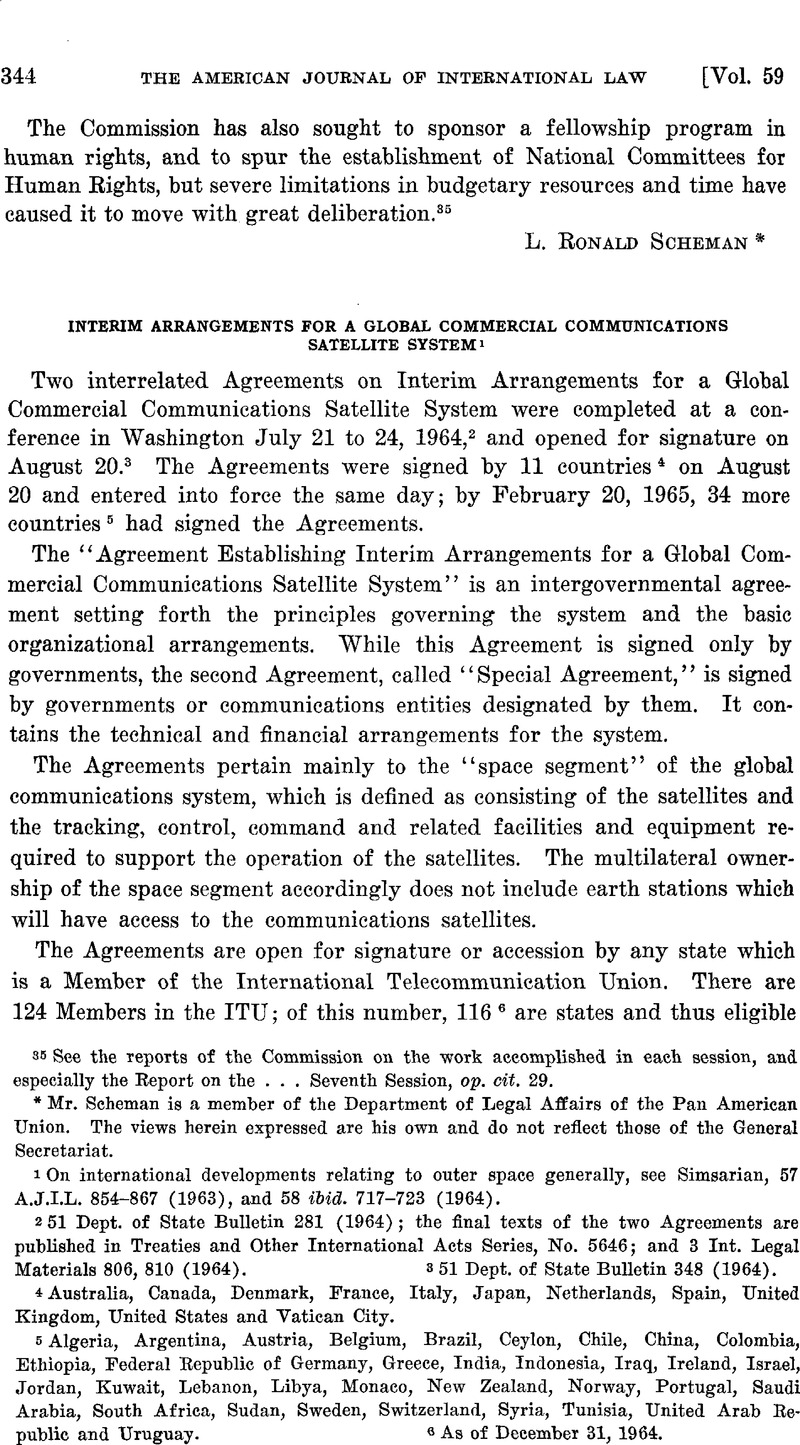Published online by Cambridge University Press: 28 March 2017

On international developments relating to outer space generally, see Simsarian, 57 A.J.I.L. 854-867 (1963), and 58 ibid. 717-723 (1964).
1 On international developments relating to outer space generally, see Simsarian, 57 A.J.I.L. 854-867 (1963), and 58 ibid. 717-723 (1964).
2 51 Dept. of State Bulletin 281 (1964); the final texts of the two Agreements are published in Treaties and Other International Acts Series, No. 5646; and 3 Int. Legal Materials 806, 810 (1964).
3 51 Dept. of State Bulletin 348 (1964).
4 Australia, Canada, Denmark, France, Italy, Japan, Netherlands, Spain, United Kingdom, United States and Vatican City.
5 Algeria, Argentina, Austria, Belgium, Brazil, Ceylon, Chile, China, Colombia, Ethiopia, Federal Republic of Germany, Greece, India, Indonesia, Iraq, Ireland, Israel, Jordan, Kuwait, Lebanon, Libya, Monaco, New Zealand, Norway, Portugal, Saudi Arabia, South Africa, Sudan, Sweden, Switzerland, Syria, Tunisia, United Arab Republic and Uruguay.
6 As of December 31, 1964.
7 All Members of the United Nations are also Members of the ITU except four new states: Malawi, Malta, Trinidad and Tobago, and Zambia. The following seven states were Members of the ITU but not Members of the United Nations as of December 31, 1964: Federal Republic of Germany, Korea, Liechtenstein, Monaco, Switzerland, Vatican City and Viet Nam.
8 Res. 1751 (XVI). General Assembly, 16th Sess., Official Records, Supp. No. 17 (Doc. A/5100), pp. 6-7; 56 A.J.I.L. 946 (1962).
9 The following quota allocations were listed in the Annex of the Special Agreement for signatories of this Agreement when it came into force on Aug. 20, 1964: Australia, 2.75; Austria, 0.2; Belgium, 1.1; Canada, 3.75; Denmark, 0.4; France, 6.1; Federal Republic of Germany, 6.1; Ireland, 0.35; Italy, 2.2; Japan, 2.0; Netherlands, 1.0; Norway, 0.4; Portugal, 0.4; Spain, 1.1; Sweden, 0.7; Switzerland, 2.0; United Kingdom, 8.4; United States, 61.0 and Vatican City, 0.05. Representatives of these 19 countries attended the July, 1964, Conference. The Committee must approve quotas for other countries signing or acceding to the Agreements.
10 p.L. 87-624, 87th Cong., H.E. 11040; 76 Stat. 419; reproduced in 1 Int. Legal Materials 331 (1962).
11 See statements of Departments of State and Communications Satellite Corporation in “Communications Satellite Act of 1962—The First Tear,” Report of House Committee on Interstate and Foreign Commerce, 88th Cong., 1st Sess., Rep. No. 809, Oct. 3, 1963, pp. 6 and 25-27; statement made by Chairman of U. S. Delegation on closing day of ITU Extraordinary Administrative Radio Conference on the allocation of frequency bands for “space communications, Nov. 8, 1963, 49 Dept. of State Bulletin 835-837 (1963); and Report on Geneva Space Radio Communication Conference and Progress Made in Establishing Global Communications Satellite System, by Congressman Harris in U. S. House of Representatives on Jan. 9, 1964, 110 Cong. Rec. (88th Cong., 2d Sess.) 159-178.
12 Report on Geneva Space Radio Communication Conference and Progress Made in Establishing Global Communications Satellite System, by Congressman Harris in V. S. House of Representatives on Jan. 9, 1964, 110 Cong. Ree. (88th Cong., 2d Sess.) 160; U.N. Doc. A/AC.105/P.V. 34, p. 41; and Richard N. Gardner, In Pursuit of World Order 233 (1964).
13 Prospectus issued by Communications Satellite Corporation, dated June 2, 1964, p. 21.
I4 For the discussion of this subject in the Committee, see U.N. Docs. A/AC.105/P.V. 26 to 34.
15 U.N. Doc. A/AC.105/22.
16 Res. 1802 (XVII). General Assembly, 17th Sess., Official Records, Supp. No. 17 (A/5217), p. 5.
17 Res. 1962 (XVIII). General Assembly, 18th Sess., Official Records, Supp. No. 15 (A/5515), p. 15; 58 A.J.I.L. 477 (1964).
18 New York Times, Dec. 4, 1964, and January 23 and 29, 1965.
19 The choice of system is essentially between the medium altitude satellite (such as TELSTAB and BELAY) and the high altitude or synchronous satellite (generally referred to as SYNCOM) or a combination of these two types of satellites. The SYNCOM orbits at an altitude of approximately 22,300 miles at a velocity equal to the rotational speed of the earth, and accordingly remains stationary in relation to a fixed point on the earth's surface. Three SYNCOM satellites would establish a global synchronous communications satellite system covering practically all parts of the earth except the Polar regions. In the case of the lower-orbit satellites, a good many more satellites are needed for global coverage.